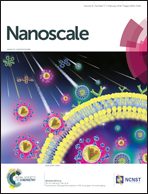Control of the composition of Pt–Ni electrocatalysts in surfactant-free synthesis using neat N-formylpiperidine†
Abstract
This paper describes the facile and surfactant-free synthesis of faceted Pt–Ni alloy nanoparticle electrocatalysts using neat N-formylpiperidine as a new type of solvent. Unlike the widely-used colloidal synthesis based on long-carbon chain surfactants, nanoparticles made in neat N-formylpiperidine possess a directly accessible surface for electrocatalytic reactions, making it a very attractive alternative solvent. The area-specific oxygen reduction reaction (ORR) activity is much higher than the commercial Pt/C catalyst reference and reaches a maximum of 1.12 mA cm−2 for the Pt–Ni alloy nanoparticles. We observed that the freshly formed Pt–Ni alloy could have controllable bulk and near surface compositions under the same initial reaction conditions and precursor ratio. The change in the composition could be attributed to the effect of CO on the formation of uniform nuclei at the initial stage, and a different deposition rate between Pt and Ni metals during the growth. The well-defined Pt–Ni nanoparticle catalysts show strong composition-dependent catalytic behavior in ORR, highlighting the important role of controlling the growth kinetics in the preparation of active Pt–Ni ORR catalysts.


 Please wait while we load your content...
Please wait while we load your content...